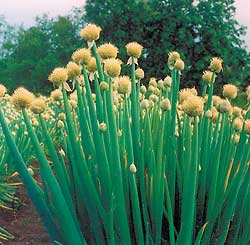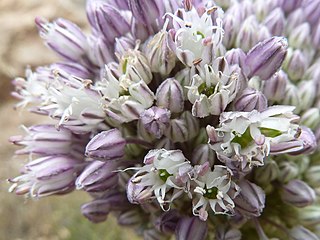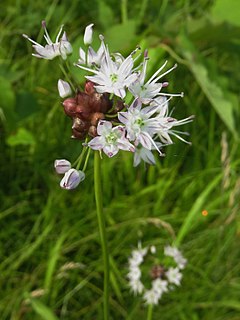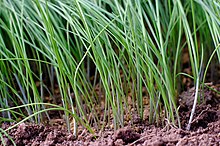
Chives, scientific name Allium schoenoprasum, is a species of flowering plant in the family Amaryllidaceae that produces edible leaves and flowers. Their close relatives include the common onions, garlic, shallot, leek, scallion, and Chinese onion.

Allium oleraceum, the field garlic, is a Eurasian species of wild onion. It is a bulbous perennial that grows wild in dry places, reaching 30 centimetres (12 in) in height. It reproduces by seed, bulbs and by the production of small bulblets in the flower head. Unlike A. vineale, it is very rare with A. oleraceum to find flower-heads containing bulbils only. In addition, the spathe in A. oleraceum is in two parts.

Allium tuberosum is a species of plant native to the Chinese province of Shanxi, and cultivated and naturalized elsewhere in Asia and around the world.

Allium fistulosum, the Welsh onion, also commonly called bunching onion, long green onion, Japanese bunching onion, and spring onion, is a species of perennial plant, often considered to be a kind of scallion.

Korean royal court cuisine was the style of cookery within Korean cuisine traditionally consumed at the court of the Joseon Dynasty, which ruled Korea from 1392 to 1910. There has been a revival of this cookery style in the 21st century. It is said that twelve dishes should be served along with rice and soup, with most dishes served in bangjja (bronzeware).

Allium ampeloprasum is a member of the onion genus Allium. The wild plant is commonly known as wild leek or broadleaf wild leek. Its native range is southern Europe to western Asia, but it is cultivated in many other places and has become naturalized in many countries.

Doenjang or soybean paste is a type of fermented bean paste made entirely of soybean and brine. It is also a byproduct of soup soy sauce production. It is sometimes used as a relish.

Cheonggukjang is a traditional Korean food made by fermenting soybeans. It contains whole, as well as ground soybeans.

Namul refers to either a variety of edible grass or leaves or seasoned herbal dishes made of them. Wild greens are called san-namul, and spring vegetables are called bom-namul. On the day of Daeboreum, the first full moon of the year, Koreans eat boreum-namul with five-grain rice. It is believed that boreum namuls eaten in winter help one to withstand the heat of the summer to come.

Doenjang-jjigae, referred in English as soybean paste stew, is a Korean traditional jjigae, made from the primary ingredient of doenjang, and additional optional ingredients vegetables, seafood, and meat. It is one of the most iconic and popular traditional dishes in Korean cuisine, and is often eaten regularly regardless of occasion or time of day. Doenjang-jjigae was initially made with home-made doenjang; however, due to extensive industrialisation of soybean paste, households and restaurants nowadays use factory-made doenjang instead as their ingredient. From traditional to modern Korean cuisine, doenjang has become one of the most frequently used jang (sauce/paste). It is claimed as a national dish.
Allium longistylum, also called riverside chive, is a species of wild onion native to Korea and northern China. It grows at elevations of 1500–3000 m.

Allium macrostemon, English name long-stamen chive, is a species of wild onion widespread across much of East Asia. It is known from many parts of China, as well as Japan, Korea, Mongolia, Tibet and Primorye. It has been collected from elevations ranging from sea level to 3000 m.

Allium ramosum, called Fragrant-flowered Garlic or Chinese chives is a northern Asian species of wild onion native to Kazakhstan, Mongolia, Siberia, the Russian Far East, and northern China. The species is also naturalized in a few places in eastern Europe. In its native range, it grows at elevations of 500–2100 m.

Allium sacculiferum, also called northern plain chive or triangular chive, is an East Asian species of wild onion native to Japan, Korea, eastern Russia, and northeastern China. It is found along the banks of lakes and rivers at elevations less than 500 m.
Allium spirale, also known as Korean aging chive, is a plant species native to Korea, Primorye, and parts of China. It is cultivated in many other regions and has for some reason obtained the common name German garlic. Other common names include spiral onion, corkscrew onion, and curly chives.

Allium thunbergii, Thunberg's chive or Thunberg garlic, is an East Asian species of wild onion native to Japan, Korea, and China. It grows at elevations up to 3000 m. The Flora of China recognizes A. tunbergii and A. stenodon as separate species, but more recent sources combine the two.

Allium ochotense, the Siberian onion, is a primarily East Asian species of wild onion native to northern Japan, Korea, China, and the Russian Far East, as well as on Attu Island in Alaska.

Siraegi (시래기) is a Korean ingredient prepared by drying the leaves and stems of a radish or, less commonly, of a napa cabbage.

Doenjang-guk (된장국) or soybean paste soup is a guk (soup) made with doenjang and other ingredients, such as vegetables, meat, and seafood. It is thinner, lighter, and milder than doenjang-jjigae. It is similar to the Japanese miso soup.






















